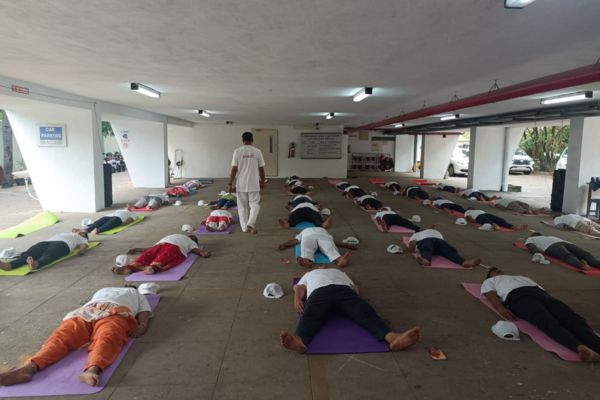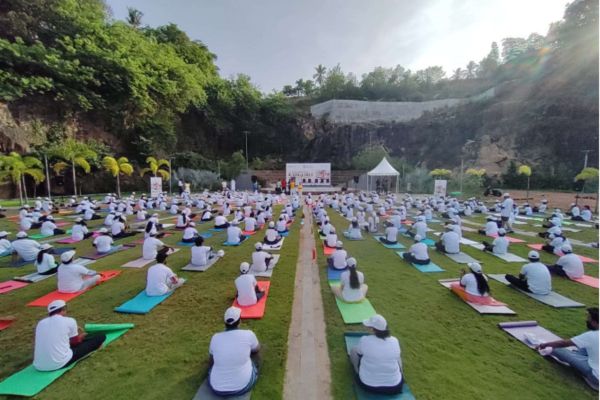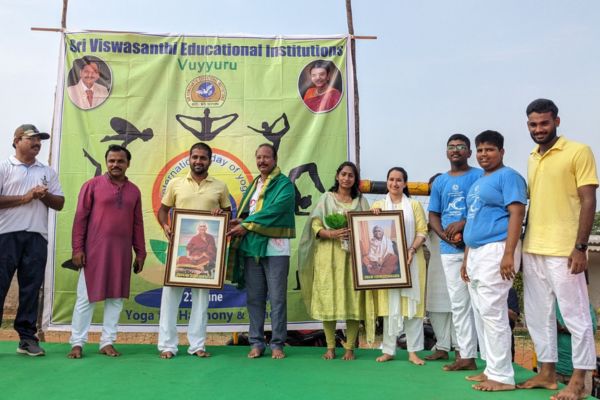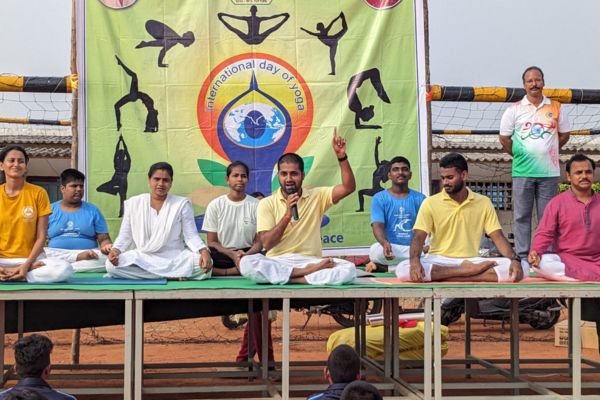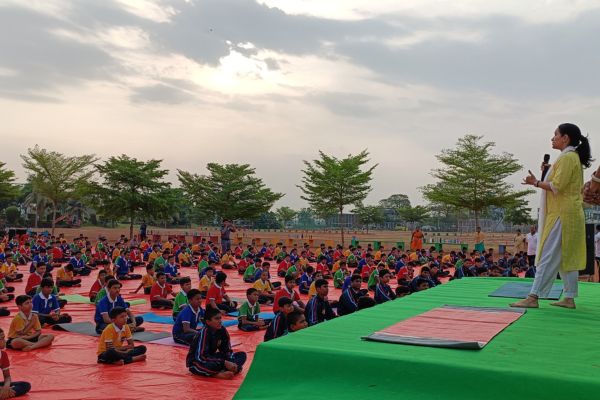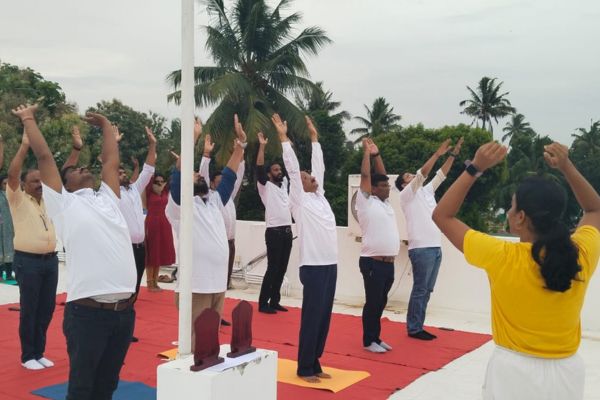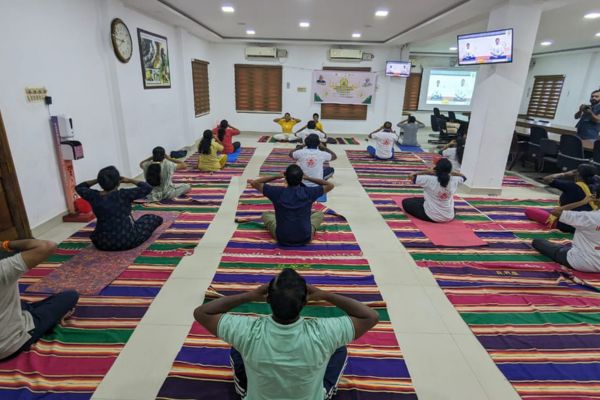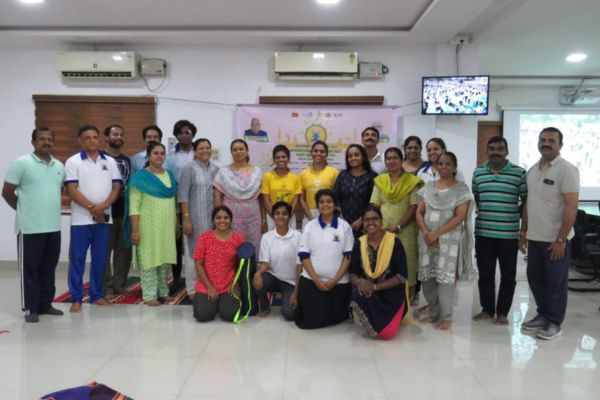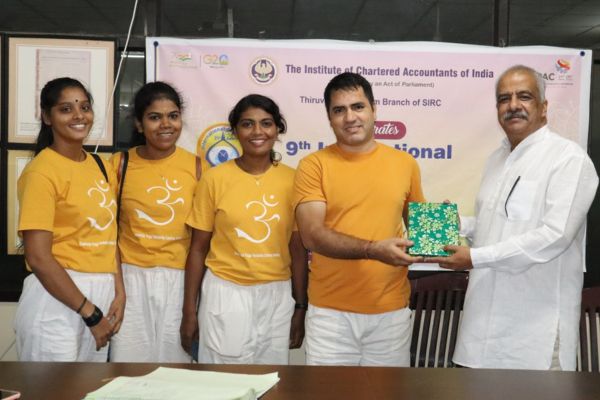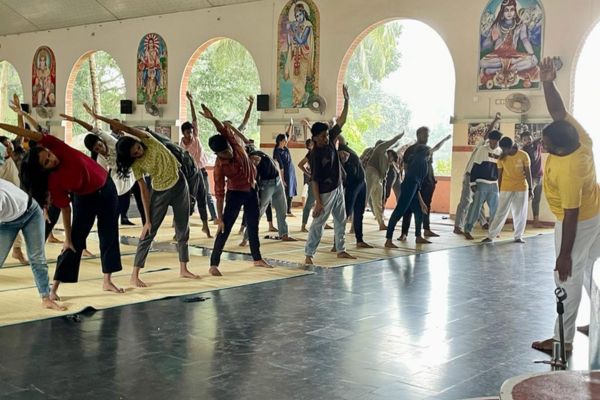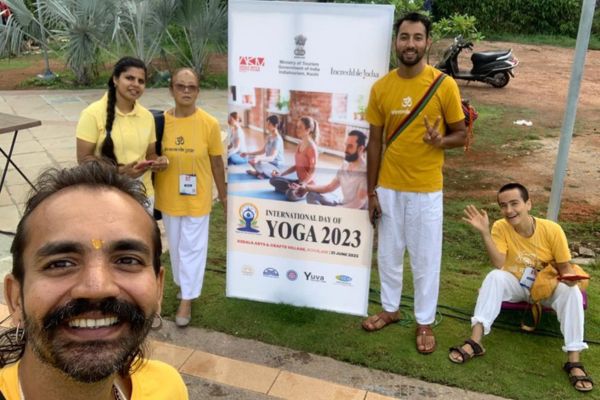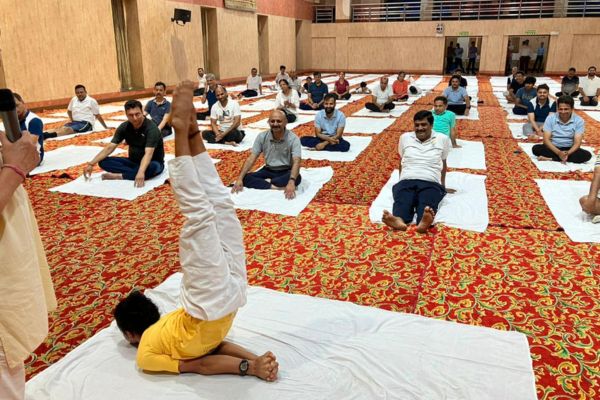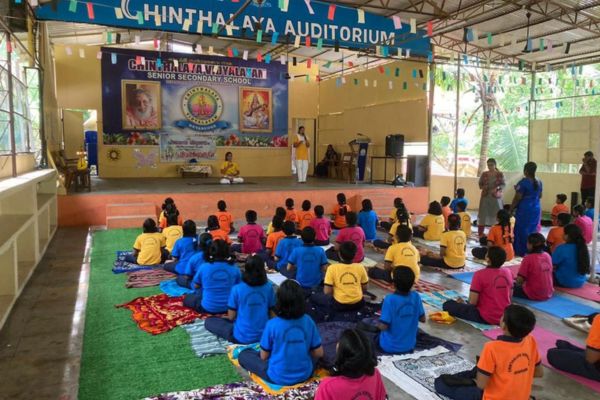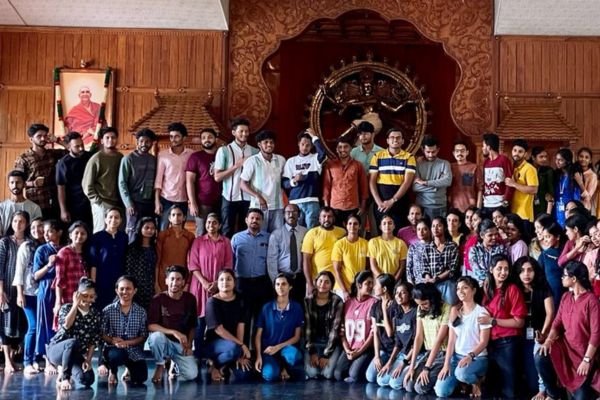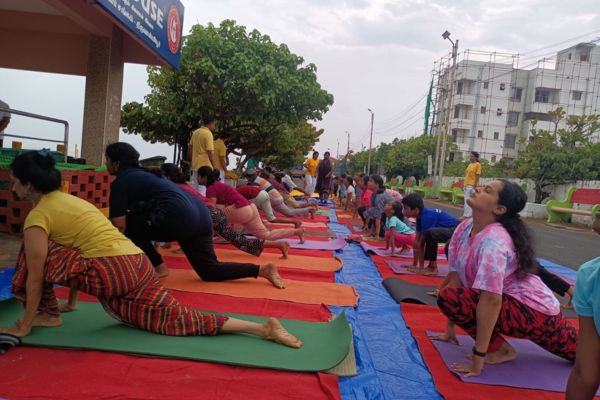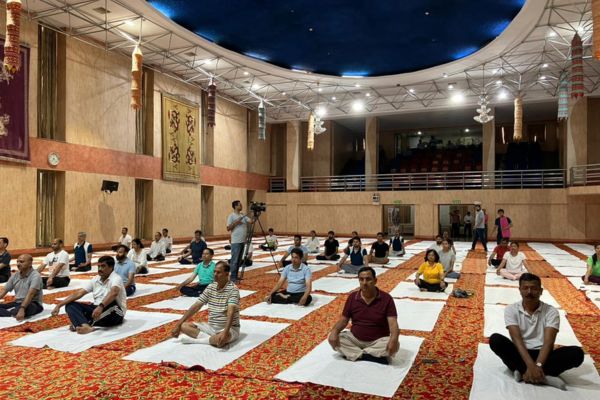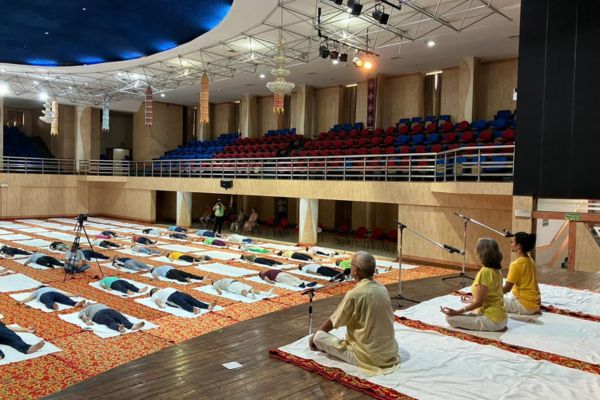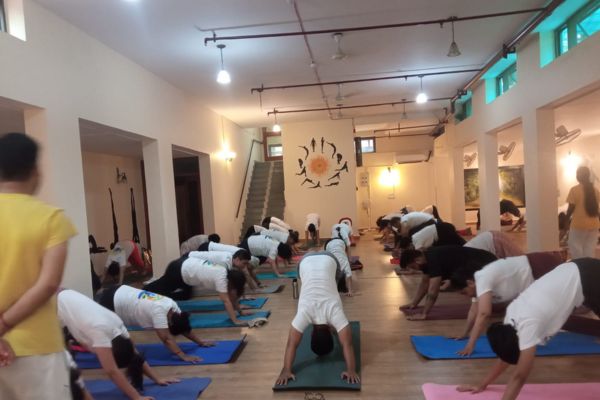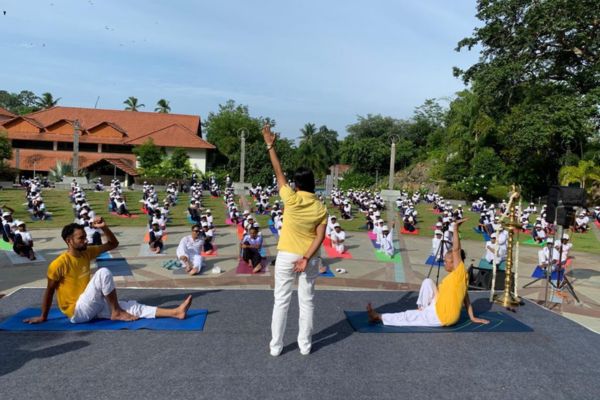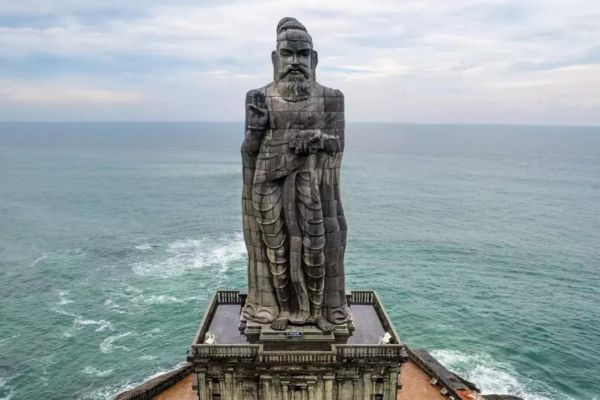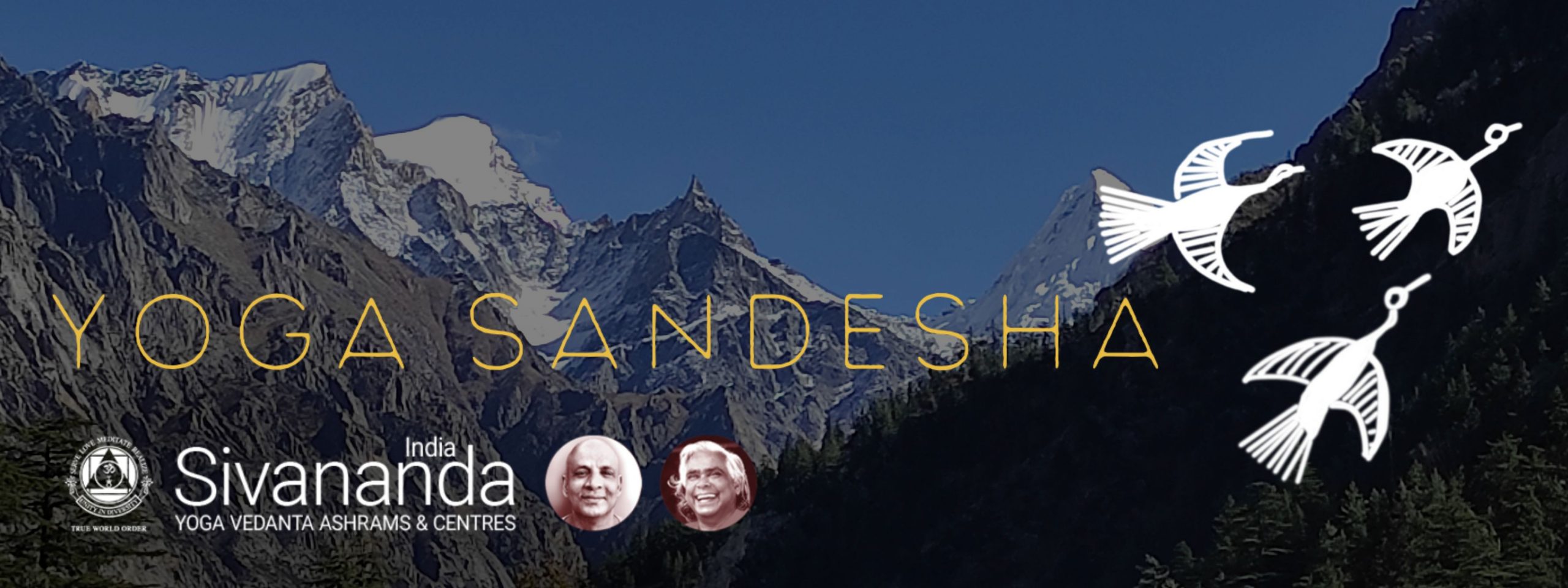
July 2023 | Focus
Om Namah Sivaya
Blessed Self,
Gurus and teachers are also human beings working through their own karma. Due to their years of contemplation and meditation, and having understood that human suffering is due to ignorance, they try to give us practical tips for how to overcome this suffering. A true teacher or guru never asks his/her disciples or followers to idolize them or call them realized saints. So, instead of idolizing teachers, imposing all our preconceived ideas on them, and expecting them to act according to our ideas, we must watch their actions and subsequent impact on the many lives around them, and embrace those ideas ourselves. We should strive to develop the gurus’ qualities that help humanity and enable us to find the purpose in our own lives. The purpose of following any inspirational teachings or work done by the gurus and teachers is to find our own peace and happiness within, and then to start seeing the same outside.
This month we would like to share two small incidents in Swami Vishnudevanandaji’s life from which we can take inspiration and life lessons.
In the Himalayas, during the last few months of Swamiji’s life, we were all travelling back after a treacherous hiking trip to Gangotri and Gomukh. By then, Swamiji’s body was crippled and he was enduring much pain and suffering, yet his mind was very strong. In that state of body, with all his will power we made it through the trip and were returning back to Uttarkashi and then onto Rishikesh. On the way, due to altitude and the winding roads he started to feel carsick. Those of us around rushed to take care of him as he was in a stretcher and vomiting. As we approached, his first question was about a staff member (a journalist devotee from Australia) who was travelling in the group and had not been feeling well the previous day. Swamiji made sure that she was alright before allowing us to take care of him. Such was his level of observation and care, always thinking about others and giving less importance to his own well-being.
We tend to always think of ourself first and not look around us. For Swamiji it was his keen observation of what each person needed, first attending to other’s needs, and doing his best to help. This quality can be observed in his teachings “do not teach what you know but teach what students need”. By doing this you grow and become selfless, annihilating the ego and developing the humility to appreciate all life and the society we live in.
On another occasion in India, while staying at the house of one of his disciples, Mr. Swami, a female ascetic came to Swamiji in tears because her mother had sustained burns to 75% of her body and was in hospital. Swamiji immediately asked all of us to repeat Trayambakams (prayers) to release her soul from that excruciating suffering. At that very moment we got a phone call from hospital telling us that she had died.
Emotions can blind us and cloud our thinking process. Swamiji taught all of us to do what is needed in each moment, when in a difficult situation.
Let’s stop judging others and take inspiration in the actions of the Saints and Gurus. Let’s come out of our own cocoon and begin to develop universal vision, leaving behind petty mindedness and selfishness. The very purpose of life is to find ways to be helpful to others, purifying ourselves in the process.
Pranams to all,
Sivananda Yoga Vedanta Ashrams & Centres, India
To focus is to give attention to one particular object, subject, or situation. In yoga we say that to concentrate, or to focus, we are making an effort, as opposed to meditation which is spontaneous. We fall into a meditative state, like we fall into sleep, but we make an effort so that we’re more likely to experience that spontaneous state. The same can be said for holding asanas for a longer time. When we hold longer, with the right focus, we may experience a state of absorption similar to meditation.
In this way, we may spend a great deal of our lives, and practice, trying to focus. It may be possible to think that we are focused when actually the mind has switched to autopilot and we’re completing a task without really thinking about it. In this newsletter we’ll explore perspectives on “focus”and how to cultivate a moment-by-moment awareness both in practice and in life. We’ll share Swami Sivananda’s words on Concentration, tips for focusing in Paschimottanasana, as well as Vedantic perspectives on focus, and why yogis avoid garlic and onions to help maintain a calm, focused mind.
We hope you enjoy the newsletter and gain some new tips and insight on how to focus. As usual, please feel free to reach out to us with your thoughts and feedback: [email protected]
News Item: International Day of Yoga Activities 2023
Here in India all our ashrams and centres celebrated the 9th International Day of Yoga on June 21 by holding a variety of events and mass yoga demonstrations in corporations, community centres, schools, colleges, temples, and even the beach–on the theme “Vasudhaiva Kutumbakam” or “The World is One Family”. We certainly felt a deepened connection and unity on this day as we connect with thousands of people and offered programmes in partnership with various esteemed groups including:
- PowerCorp, Delhi
- Ministry of AYUSH Mass Yoga Demonstration, Delhi
- Tamil Nadu Maritime Board
- Kerala Arts & Crafts Village
- The Institute of Chartered Accountants of India
Photo Update: International Day of Yoga Celebrated by Our Ashrams and Centres
Enjoy a selection of photos of our staff, students, and members of the public participating in International Day of Yoga programmes on June 21, 2023 in various locations around India.
Research/Links
- A Harvard study shows that 47% of our waking lives are spent thinking about something other than what we’re doing. Read more here: news.harvard.edu/gazette/story/2010/11/wandering-mind-not-a-happy-mind/
- The biggest hindrance in a Yoga practice is one’s intention to keep going with the practice. Maintaining a regular Yoga practice is a must to gain the benefits of a Yoga practice. This research study presents the information regarding therapeutic effects of Yoga for various body-mind ailments and its capacity to improve quality of life when practiced regularly.
www.ncbi.nlm.nih.gov/pmc/articles/PMC3193654/
Spiritual Calendar
July 3 – Full Moon
July 3 – Guru Poornima
July 13 – Ekadasi
July 14 – Master’s Mahasamadhi
July 17 – New Moon
July 29 – Ekadasi
Upcoming Courses:
Learn, Practise & Grow with Us!
Teachers’ Training Course (TTC)
July 23 to August 19, Netala, Himalayas
August 13 to September 9, Neyyar Dam, Kerala
September 10 to October 7, Netala, Himalayas
October 15 to November 11, Madurai, Tamil Nadu
For more details, click here
ONLINE Adapted Sivananda Yoga Course (ASYC)
July 23 to 30, 2023 on Zoom
For more details, click here
Continuing Education
Sadhana Mandalam Course
August 1 to September 10, Neyyar Dam, Kerala
For more details, click here
Sadhana Intensive Course
October 15 to 28, Netala, Himalayas
For more details, click here
Courses in Thailand this fall at the Phu Chaisai Mountain Resort in Chiang Rai
Sadhana Intensive, September 16 to 30, 2023
Teachers’ Training Course, October 1 to 28, 2023
Advanced Teachers’ Training Course, October 1 to 28, 2023
Yoga Vacation, October 7 to 11 and October 21 to 25, 2023
For more details, click here
Teachings Excerpt:
Concentration by Swami Sivananda
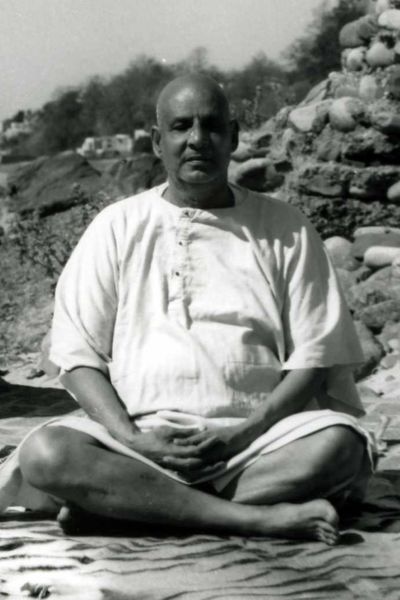
Sit on any comfortable pose. Place a picture of your Ishta Devata in front of you. Look at the picture with a steady gaze. Then close your eyes and visualise the picture in the centre of your heart or in the space between the eyebrows.
When the picture fades out in your mental vision, open the eyes and gaze at the picture again. Close your eyes after a few seconds and repeat the process.
It is easy to concentrate the mind on external objects. The mind has a natural tendency to go outwards. In the beginning stage of practice, you can concentrate on a black dot. on the wall, a candle flame, a bright star, the moon, or any other object that is pleasing to the mind.
The mind should be trained to concentrate on gross objects in the beginning; and later on, you can successfully concentrate on subtle objects and abstract ideas.
There is no concentration without something to rest the mind upon. Concentrate on anything that appeals to you as good or anything which the mind likes best. It is very difficult to fix the mind, in the beginning, on any object which the mind dislikes.
Practise various sorts of concentration. This will train or discipline your mind wonderfully. Now concentrate on the Himalayas, a very great object. Then concentrate on a mustard or a pin-point. Now concentrate on a distant object. Then concentrate on a near object. Now concentrate on a colour, sound, touch, smell, or taste. Then concentrate on the ‘tik-tik’ of a watch. Now concentrate on the virtue ‘mercy’. Then concentrate on the virtue ‘patience’. Now concentrate on the Sloka, “Jyotishamai Tat Jyotih”. Then concentrate on “Satyam Jnanam Anantam”. Now concentrate on the image of Lord Siva. Then concentrate on the “Aham Brahmasmi” Mahavakya.
Concentration is purely a mental process. It needs an inward turning of the mind. It is not a muscular exercise. There should be no undue strain on the brain. You should not fight and wrestle with the mind violently.
When you concentrate on any object, avoid tension anywhere in the body or mind. Think gently of the object in a continuous manner. Do not allow the mind to wander away.
Those who practise concentration evolve quickly. They can do any work with scientific accuracy and great efficiency. What others do in six hours can be done, by one who has concentration, within half an hour. What others read in six hours can be read, by one who does concentration, within half an hour. Concentration purifies and calms the surging emotions, strengthens the current of thought, and clarifies the ideas.
Concentration helps a man in his material progress also. He will have a very good out-turn of work in his office or business house. He who practises concentration will possess very clear mental vision. What was cloudy and hazy before becomes clear and definite now. What was difficult before becomes easy now. And what was complex, bewildering, and confusing before comes easily within the mental grasp. You can achieve anything through concentration. Nothing is impossible to a man who practises regular concentration.
It helps the scientists and professors to do great research work. It helps the doctor and the lawyer to do much work and earn more money. It develops will-power and memory; it sharpens and brightens the intellect. Concentration bestows serenity or calmness of mind, inner spiritual strength, patience, great capacity to turn out tremendous work, alacrity, acumen, agility, beautiful complexion, sweet voice, brilliant eyes, powerful voice and speech, power to influence others and attract people, cheerfulness, joy, bliss of soul, supreme peace. It removes restlessness, agitation of mind, laziness. It makes you fearless and unattached. It helps you to attain God- realisation.
The more is the mind fixed on God the more is the strength you will acquire. More concentration means more energy. Concentration opens the inner chambers of love or the realm of eternity. Concentration is a source of spiritual strength.
Be slow and steady in concentration. By practice of concentration, you will become superhuman.
Those who practise concentration off and on will have a steady mind only occasionally. Sometimes the mind will begin to wander and will be quite unfit for application. You must have a mind that will obey you at all times sincerely and carry out all your commands in the best possible manner at any time. Steady and systematic practice of Raja Yoga will make the mind very obedient and faithful. You will be successful in every attempt. You will never meet with failure.
Teaching & Practice Tips:
How to Focus in Paschimottanasana
It is said that Paschimottanasana, the Sitting Forward Bend reveals a lot about where we are in our yoga practice. Not necessarily how flexible we are but whether we are practicing regularly and whether we are able to focus. We often see students (and ourselves) fidgeting in the forward bend, picking at toenail polish, looking around, playing with the phone (gasp!), bouncing up and down, or holding only for a very short time. In the following video we present a few strategies for achieving mental focus and for staying in the asana longer. We hope it’s helpful!
Temple Showcase:
Vivekananda Rock Memorial, Kanyakumari, Tamilnadu
Vivekananda Rock is one of the most popular places to visit in South India. It is the place where Swami Vivekananda attained enlightenment. The rock, considered to have holy vibrations, was inaugurated in 1970 in the memory of Swami Vivekananda who popularized Yoga and Vedanta philosophy in the West.
Located in the midst of the sea about 500 meters from mainland of Vayathurai in Kanyakumari, the Vivekananda Rock is an epitome of spirituality surrounded by the mystic vibrations of sea waters and the spiritual vibrations of one of India’s most renowned modern yoga gurus. The rock stands right at the point where the Bay of Bengal and the Arabian Sea meet, making it a magnificent tourist attraction for people from all walks of life. Even if meditation, yoga, and spirituality is not your interest, still the place offers a magnificent scenic beauty to enjoy the positivity and tranquillity of the space.
A large statue of Thiruvalluvar, the Tamil poet stands at Vivekananda Rock. Thiruvalluvar was the author of the Tirukkural, an exceptional text on ethics, emphasising self-discipline, honesty, and equality, a cherished work of Tamil literature.
However, the main attractions at the Vivekananda Rock are its mandapas, the ‘Shripada Mandapam’ and the ‘Vivekananda Mandapam’. The Shripada Mandapam houses a study hall and a museum, that showcases the life of Swami Vivekananda. The attraction for yogis is the ‘Dhyana Mandapam’, a meditation hall with spiritual vibes and six adjacent rooms. It is said that just by sitting in the Dhyana Mandapam you can easily focus the mind without any effort. A grainy photo of the Dhyana Mandapam is included here.
Kanyakumari is just a few hours’ drive from our ashram in Neyyar Dam and is one of the locations we frequently arrange day trips for the ashram guests to visit. A must visit place at the southern-most tip of India.
From the Community:
Cultivating Focus: An Insight Through the Lens of Vedanta by Swami Tanmayi Maiya
In a world that is increasingly distracted, the ability to focus is a priceless internal commodity to possess. Vedanta, the bedrock of life and ancient wisdom, when studied provides not just insights but also practical guidelines on how to cultivate focus. These insights are more relevant in today’s world than ever.
Vedanta is not mere philosophy; it is practical truth. The study of Vedanta, followed by an integration of its principles helps clear clutter in the mind, sharpen the mind, and enhance productivity. Vedanta’s ultimate aim is to understand the Self. This is realised due to the clarity and subtlety of the mind, by dropping the repeated conditionings of lifetimes, and by clearing away of ignorance.
Vedānta texts like the Upanishads and the Bhagavad Gītā state that, by its very nature, the mind is restless, easily distracted, and constantly moving. However, it is possible to intelligently direct the mind to a state of focus. In the Bhagavad Gita, Shri Krishna says:
asamshayam mahābāho mano durnigraham chalam
abhyāsena tu kaunteya vairāgyena cha grhyate. (6:35)
Without a doubt, O mighty-armed Arjuna, the mind is difficult to control and is restless. However, with practice and with detachment it can be self-possessed.
Saying “the mind can be self-possessed” essentially means that the mind can be trained to focus. Vedānta offers many perspectives on how to focus. Here are just a few of them:
Viveka, or discernment is the first stepping-stone to Vedānta; the ability to differentiate eternal from non-eternal, or real from unreal. An understanding of what is unchangingly eternal and of what is eternally changing and impermanent, helps gain perspective in life. The practice of looking at the innate nature of something, of whether it is eternal or non-eternal in nature, helps to weaken our dependence on distractions, and to focus on that which truly matters.

Study of scriptures: A systematic study of Vedānta in an appropriate manner, over a sufficient period of time, offers the framework to understand the self, the world, and reality. Studying these texts under the guidance of a teacher who lives and breathes the teachings of Vedānta can help us gain mental and intellectual clarity, by focusing on the ultimate truth.
Self-enquiry is a powerful means of focusing the mind. Vedānta urges the seeker to go beyond what the eyes, the ears, the senses, and even the mind can perceive and process, and to enquire into the nature of reality itself. Vedānta tells us to enquire: “who am I?”. This focused contemplation, or mananam, supported by shruti vākya–statements of the Upanishads to contemplate upon–detaches us from external and internal distractions to develop a deeper sense of self-awareness.
Vairāgya, or Detachment does not mean dropping all the objects of the world and turning away from our responsibilities and life itself. It implies having a healthy attitude towards the world, objects, work, and relationships. Vairāgya is the practice of letting go of attachment to things that might come our way, or go away from us and dropping attachment to the expectations of others, or the outcomes of our own actions. Letting go of attachments in this manner helps the mind be less dispersed and completely focused on the present.
The above point is more specifically stated in the Bhagavad Gītā. The practice of doing one’s duties, or any work, without like or dislike of the work itself, and without an attachment to the expected result, has been termed Karma Yoga. This way of doing actions, performing one’s work and duties can lead to a state of balance, and helps us to be focused when faced with distractions and difficult situations.
Bhakti, or Devotion: Vedānta underlines the importance of bhakti or devotion for mental clarity and focus. In fact, the Bhagavad Gītā has an entire chapter that focuses on the aspect of devotion, faith in a universal power, and surrender to a higher power who causes the natural order of the universe to flow effortlessly, beautifully. Devotion is the pillar supporting karma yoga, supporting self-enquiry, and all other spiritual practices. Devotion is a complete surrender to Ishvara. We offer all our actions to the divine, accept whatever comes our way as sent by the divine, and cultivate a burning desire to understand the divine for oneself. This bhāva, or attitude is a powerful way to cultivate a focused mind.
Vedānta reveals the ultimate reality of the self. It encourages the seeker to integrate its teachings and practices with one’s duties, work, and relationships. Vedanta helps us to achieve a focused mind in all aspects of life, by understanding the essential non-difference or unity of all things that seem to be differentiated.
Nutritional Tips:
Garlic and Onions from Both Yogic and Ayurvedic Perspectives
One of the most common questions we receive about a yogic diet is why garlic and onions are not consumed. Those wondering why will enjoy the following perspective.
Garlic and onions are not recommended in both Yoga and Ayurveda. Even though they have significant medicinal and scientific properties, energetically, onions and garlic are prohibited in many cultures. Interestingly, there is a legend associated with the origin of garlic and onions. It is believed that while Lord Vishnu was busy serving the nectar of immortality to Rahu and Ketu, they informed Lord Vishnu of their actual demonic existence. Since Lord Vishnu had already served them the nectar, he immediately beheaded them and a few drops of their blood fell to the ground. As per the legends, onions and garlic sprouted from this odd combination of demonic blood and the nectar of immortality. Therefore, from the perspective of Ayurveda and Yoga, these vegetables offer potentially high medicinal properties (the nectar analogy) while also exerting destabilizing effects on the mind activity (the demonic analogy).

In Ayurveda the idea of diet begins more with the energetic properties and taste of the foods and their impact on our body and mind, than their nutritional properties. In Yoga the purpose of practice is to keep the state of mind uplifted and calm, and to keep the body light and energetic. To keep mind in a conducive state for meditation and the body energetic and balanced, both Ayurveda and Yoga recommend a sattvic diet that eliminates these two foods due to their highly stimulating properties.
Yoga and Ayurveda consider food as energy and each food has a specific impact on our energetic traits. When we consume foods that help give rise to negative qualities in the mind, such as stimulation, aggression, anger, irritability or overexcitement, irrespective of their positive nutritional profile, we directly tax the nervous system with these stimulating traits of the mind, weakening our system further. Onions and garlic are considered to be rajasic (stimulating) foods that cause overstimulation, generate excess heat and energy in the body and these heating qualities may trigger anger, aggression, and irritability. The taste of onions and garlic is pungent, and Ayurveda explains the properties of pungent foods as heating and increasing bile in the body. Therefore, many yoga practitioners stay away from these two foods or consume them minimally.
“When the potential contained in the power of thought is realized, it is the beginning of great spiritual growth in the individual.” -Swami Vishnudevananda


